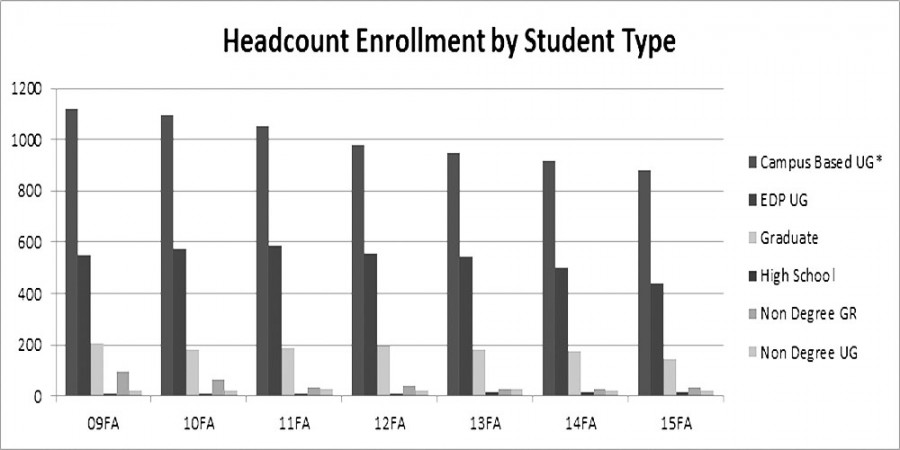Johnson State’s enrollment continues to decline
JSC’s fall 2015 enrollment data is in and the trend of a moderately declining student population appears to continue into the new semester.
The same pattern is replicated across nearly every major.
“Certainly it’s no surprise,” said Doug Eastman, who works as a registrar for the college, “that overall headcounts have been decreasing.”
Eastman prepared the data, which was emailed to the President’s Council on October 16.
“This is just sort of the point in time totals,” said Eastman. “I’ve not gotten into sort of, ‘how we got there,’ sort of questions. Like, we see a drop in enrollment, is it a drop in new students? Returning students as juniors? I’ve not gone there yet. This is really pretty fresh.”
The overall headcount graph in the report indicates that the declining trend began in the Fall 2009 semester, which peaked at exactly 2000 students, and has continued every year since, decreasing to 1538 students as of the fall 2015 semester.
The population of campus-based in-state undergraduates remained basically unchanged, decreasing from 682 students in Fall 2014 to 681 students in Fall 2015. During the same period, campus-based out-of-state undergraduates decreased from 238 to 200, a 15.9 percent decrease.
The declining student population represents a serious challenge for efforts to resolve the college’s budgetary issues, given that student tuition accounts for a large portion of the college’s aggregate income.
“Again,” said Eastman, “I don’t have proof [of whether] it’s incoming numbers vs returning student numbers, but we’ve been seeing that same sort of decline for some time. It’s not what we want to see, but it’s also not surprising.”
Both in-state and out-of-state student populations are in decline, which, according to Eastman, indicates that larger demographic shifts in New England are likely at play.
“I think most of this change in head count has to do with primarily the demographic shifts. There’s just less students coming out of high school and so there’s less students, not only to market to, but the enrollment environment is much more competitive among colleges because we’re all trying to attract the same students,” said Eastman.
“There are different pockets in the country,” continued Eastman, “of increased numbers of students and then there are others with decreased numbers of students. That has to do both with population migration to new areas and then also birth rates in various areas. New England is pretty hard hit in terms of the demographic shift.”
In general, the report isn’t positive news for the college. However, according to Eastman, retention rates can be seen as a bright spot in an otherwise less-than-ideal overall picture. “I will tell you that if anything we’ve seen a bit of an uptick [over the last few years] in the data points with regard to student retention. Not only with first year retention, but of those sort of sophomore to junior, junior to senior sort of things. Not huge spikes, but we’re not seeing drops in retention,” said Eastman.




